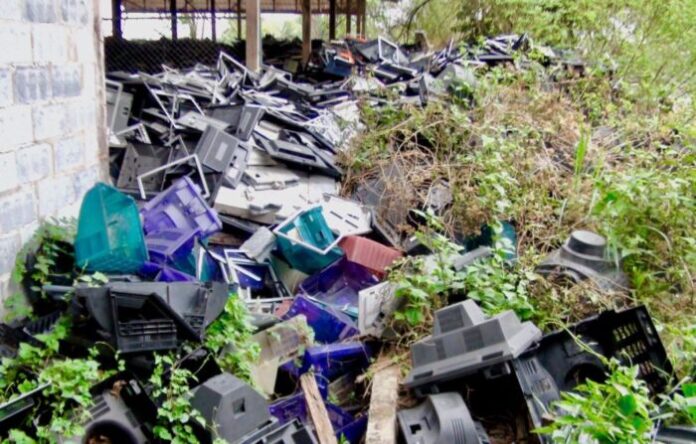
Over 365 thousand tons of waste from electrical and electronic equipment (WEEE) sent for proper disposal in Italy in 2020. This is what emerges from the analysis of the data released by the WEEE Coordination Center. This is an extremely positive result, up by more than 6% compared to 2019, confirming the trend that has emerged in recent years and confirmed despite the difficulties deriving from the Covid-19 pandemic.
The main data on the collection of WEEE in 2020 were presented in the Annual Report 2020 which collects and summarizes the results achieved by the individual Collective Systems, and is therefore the only report capable of photographing the trend of the collection of domestic WEEE in its entirety. nationwide.
“We are particularly satisfied with the results obtained in such a dramatic year as 2020, which saw us Collective Systems and all collection managers – Municipalities, waste management companies rather than distributors and installers of electrical and electronic equipment – hardly committed not to interrupt the activity of the system and guarantee citizens a primary service such as that of the collection of WEEE ”, comments Bruno Rebolini, president of the WEEE Coordination Center.
National data collection WEEE 2020
During 2020, the Collective Systems managed a total of 365,897 tons of WEEE throughout the country, including voluntary collection, almost 22,000 tons more than in 2019, equal to + 6.35%. The average per capita collection is also growing and is expected to reach 6.14 kg per inhabitant, equal to + 7.7%.
Read also: Separate collection: how to properly dispose of WEEE waste
Just over 81% of the total volumes come from the municipal collection centers present in all regions, while about 18% of the collection was conveyed by the distribution grouping places (LdR), the sites that receive WEEE from the “1 against 1” and “1 against 0” withdrawals, albeit with an uneven distribution on the territory. It should be emphasized that out of the total volumes moved by the LdR, the largest quantities refer to WEEE related to cold and climate (R1), and to large whites (R2), with incidences of 22% and 34%, while the impact on other clusters are significantly lower (less than 2.5%).
The remaining volumes, mainly related to the collection of WEEE in the lighting (R5) and small household appliances (R4) categories, derive from the contributions of installers, large users and private collection centers.
The ranking of the five groups
In 2020 almost all the groups in which the collection of WEEE is organized recorded an increase: the most significant, equal to + 9.1%, is for the great whites (R2) whose weight stands at 125,623 tons, thus confirming the types of end-of-life equipment most collected which represent over a third of the total collection.

The grouping of small household appliances and consumer electronics (R4) is also growing, reaching 78,422 tons with + 7.7%. The excellent trend started in 2018 continues, also supported by the communication campaign promoted by the WEEE Coordination Center.
More contained, but still positive and equal to + 4% and + 3.7%, the increases in devices with screens (R3), and in the cold and climate (R1) which weigh 62,272 and 96,945 tons respectively. In contrast with the remaining groupings and down compared to the result of the previous year, the collection of light sources (R5) which marks a -5.8% for a total of 2,635 tons, thus interrupting the growth started in 2018.
The geographical collection
While confirming the positive trend of collection throughout the country, in analogy with previous years, the 2020 Annual Report highlights some peculiarities between the different areas: both Northern and Central Italy increase their quantities compared to the previous year, but it is in the South, which recorded the most significant and sustained growth, this is a positive sign that demonstrates how the southern regions have taken the necessary actions to achieve collection targets in line with the rest of Italy. The situation of per capita deposits is similar, growing throughout the country, but more sustained in the South.
Five out of seven regions show double-digit percentage increases, the best at national level; Basilicata stands out among these, with + 78.4% favored by the important performance of a single collection center. Sicily (+ 28%) and Puglia (+ 21.8%) follow for growth trend; Molise records an increase in deposits equal to + 16.3% and Calabria by 11.3%. Growth was more contained in Campania with + 7.8% and in Sardinia with + 3.4%.
The average per capita collection is also growing, reaching 4.70 kg per inhabitant, thus reducing the gap compared to the Italian average.
Sardinia confirms the second position at national level, with a per capita figure of 8.71 kg / inhabitant, followed by Basilicata which with 8.55 kg / inhabitant also conquers third place in the national ranking. All the remaining regions of the area remain below the national average, in particular Sicily (4.44 kg / inhabitant), Puglia (4.26 kg / inhabitant) and Campania (3.51 kg / inhabitant) are the last three regions by per capita collection, still far from the Italian average.



































